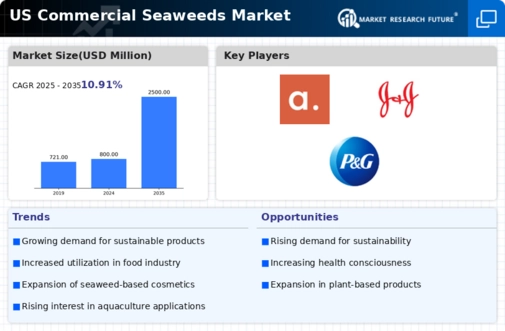Health Benefits of Seaweeds
The commercial seaweeds market is experiencing a notable surge due to the increasing awareness of the health benefits associated with seaweed consumption. Rich in vitamins, minerals, and antioxidants, seaweeds are being recognized for their potential to enhance overall health. Studies indicate that seaweeds can aid in weight management, improve gut health, and provide essential nutrients that are often lacking in modern diets. As consumers in the US become more health-conscious, the demand for seaweed-based products is likely to rise. This trend is reflected in the market data, which shows that the commercial seaweeds market was projected to grow at a CAGR of approximately 8% over the next five years, driven by the rising interest in functional foods and dietary supplements.
Expansion of Food Applications
The versatility of seaweeds in various culinary applications is significantly driving the commercial seaweeds market. From sushi to salads, and even as a thickening agent in soups, seaweeds are being increasingly incorporated into diverse food products. The growing trend of fusion cuisine in the US has led to innovative uses of seaweeds, appealing to a broader consumer base. Additionally, the food industry is witnessing a shift towards natural ingredients, further enhancing the appeal of seaweeds. Market analysis suggests that the food segment of the commercial seaweeds market is expected to account for over 60% of the total market share by 2026, indicating a robust growth trajectory fueled by consumer preferences for healthier and more sustainable food options.
Growing Popularity of Seaweed Snacks
The rise of seaweed snacks is significantly influencing the commercial seaweeds market. These snacks, often marketed as healthy alternatives to traditional chips, are gaining traction among health-conscious consumers in the US. The appeal of seaweed snacks lies in their low-calorie content, high nutritional value, and unique flavors. Market data indicates that the seaweed snack segment is projected to grow by over 25% in the next five years, driven by increasing consumer interest in convenient and nutritious snack options. This trend not only reflects changing dietary habits but also highlights the potential for innovation within the commercial seaweeds market, as manufacturers explore new flavors and formats to attract a wider audience.
Rising Interest in Sustainable Sourcing
Sustainability is becoming a pivotal factor influencing consumer choices, thereby impacting the commercial seaweeds market. As environmental concerns grow, consumers are increasingly seeking products that are sustainably sourced. Seaweeds, being a renewable resource that requires minimal land and water, are viewed as an eco-friendly alternative to traditional agricultural products. This shift towards sustainable sourcing is prompting companies to adopt responsible harvesting practices, which not only appeal to environmentally conscious consumers but also enhance brand loyalty. The commercial seaweeds market is likely to benefit from this trend, as it aligns with the broader movement towards sustainability in food production, potentially increasing market share by 15% in the coming years.
Technological Advancements in Cultivation
Technological innovations in seaweed cultivation are playing a crucial role in shaping the commercial seaweeds market. Advances in aquaculture techniques, such as improved breeding methods and cultivation systems, are enhancing yield and quality. These innovations are enabling producers to meet the growing demand for seaweeds while ensuring sustainability. Moreover, the integration of technology in monitoring and managing seaweed farms is likely to reduce operational costs and increase efficiency. As a result, the commercial seaweeds market is expected to see a rise in production capacity, potentially increasing output by 20% over the next few years, thereby supporting the burgeoning demand from various sectors.














Leave a Comment